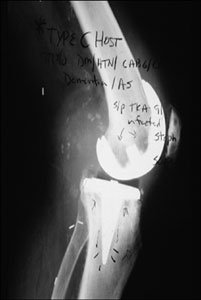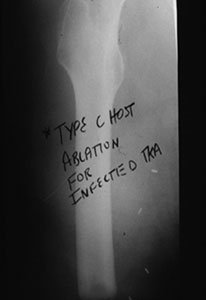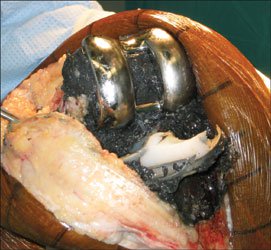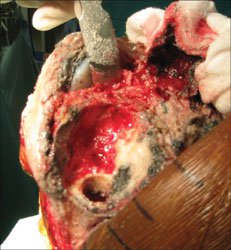The three As of joint replacement can address failed total knee arthroplasty
Arthrodesis, amputation or resection arthroplasty can offer satisfaction to some patients.
Patients with failed total knee arthroplasties may not be candidates for revision arthroplasty or rotating hinge prostheses due to infection, systemic wound problems and massive bone loss; however, there are other options they may be amenable to, according to an orthopedist from Dallas.
“What you are left with then are the three As: arthrodesis, (resection arthroplasty), or amputation,” Richard E. Jones, MD, said.
Each of these approaches has relative indications, contraindications and critical pitfalls to avoid, Jones said at the 2009 Current Concepts in Joint Replacement Spring Meeting, warning his colleagues that resection arthroplasty will likely be unacceptable to their patients.
Healing status
The good news for individuals whose total knee arthroplasty (TKA) has failed catastrophically is they may be able to obtain a good result with one of these options.
To identify the treatment with the greatest odds of achieving a reliable outcome, Jones recommended assessing the patient’s host healing capacity as normal, type A, with a locally or systemically compromised wound, type B, or with severely compromised healing, type C.
|
|
|
|
Patients who are type C hosts have severely compromised healing, a life-threatening infection or have failed multiple TKA revisions with a low chance of obtaining a successful fusion. They prove to be the best candidates for an above-knee amputation and subsequent fitting for an ambulatory prosthesis. Images: Jones RE |
|
He frequently resorts to using arthrodesis in these cases, fusing the knee at 15· flexion and 5· to 7· valgus with correct rotation.
For an arthrodesis to be successful infection must be fully eradicated and all residual implants removed, Jones said.
Arthrodesis can be performed using intramedullary (IM) fixation or external fixation, which can be adjusted for a more custom result. Jones has found IM nails most effective when there is sufficient bone, but he also opts for modular locking nails locked on the femoral side.
“You do not want to have any distraction of your IM nail technique,” he explained.
Resection arthroplasty
“Plate fixation techniques work for salvage of failed arthrodesis,” Jones said, adding that he uses two contoured plates and places them anteriorly and laterally.
“You can supplement that with bone graft if you have no infection,” he said.
Resection arthroplasty is indicated for infected knees associated with extensive loss of hard and/or soft tissue. But because patients typically find this option unacceptable, Jones recommended using it mostly as a staged procedure after a failed arthrodesis.
When problems persist despite multiple revision surgeries of all kinds or the patient develops an intractable or life-threatening infection, an above-knee amputation is traditionally the only option. Ambulating with an above-knee prosthesis is difficult for many elderly patients, so Jones suggested considering this option on a case-by-case basis in such individuals.
|
|
|
|
A rotating hinge prosthesis is indicated for massive hard and soft tissue defects like these that occur after total knee arthroplasty (TKA) and when there is loss of medial and lateral collateral ligaments. |
|
For more information:
- Richard E. Jones, MD, can be reached at Orthopedic Specialists, 5920 Forest Park Rd., Suite 600, Dallas, TX 75235-6411; 214-902-1431; e-mail: ghooker@orthopedicspecialist.com. He has no direct financial interest in any products or companies mentioned in this article.
Reference:
- Jones RE. End game: Alternatives for the multiply operated patient. #57. Presented at the 10th Annual Current Concepts in Joint Replacement Spring Meeting. May 17-20, 2009. Las Vegas.




